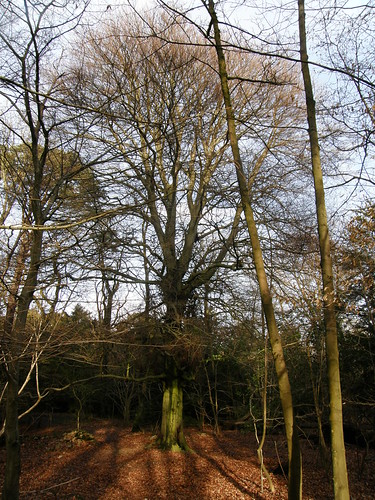
In the car we’d been listening to Michael Hordern read ‘Prince Caspian’. I suspect that Michael Hordern could have made almost anything interesting to listen to, but the kids are quite Narnia obsessed at the moment. A has begun to read the books, the kids have all seen the films – in fact they had watched ‘The Voyage of the Dawn Treader’ at the flicks the day before with their mum whilst I was painting – and they are already busy preparing their costumes as characters from ‘The Lion, the Witch and the Wardrobe’ for World Book Day. Today their mum had taken over the painting duties (fiddly stuff involving gloss paints and woodwork – beyond my meagre capabilities) and I was making a virtue of necessity and taking the rest of the crew for a staycation exploration day.
At the beginning of ‘Prince Caspian’ Peter, Susan, Edmund and Lucy unexpectedly find themselves in a wood, by a shore. They soon find a stream across the beach, and then the ruins of Cair Paravel in which they find a well. In the cold and the mist we embarked into a wood, by a shore. The kids soon found a rivulet issuing from a black plastic pipe. Just into the wood we found a mysterious ditch…

…at the end of which there was……a well!

…or something the kids were happy to believe was a well. I soon found that my companions had been renamed Peter, Edmund and Lucy. Lucy found a rough circle of erratic boulders, which she announced were the ruins of Cair Paravel’s keep and the magic was complete.
Whilst their imaginations ran wild, I was noticing that the Ramson leaves are much more advanced than the ones I spotted earlier in the week in Bottoms Wood near home.

Spent puffballs.
We followed the lower edge of the woods and when we ran out of wood we turned about and came back along the foreshore.

Sea Wood
Lucy had turned to beachcombing and was filling her pockets with stones and shells…

The boys were enjoying the mud and puddles and scrambling on the low cliffs. They were particularly taken with one twisted oak, the roots of which had been exposed by erosion, leaving a a space into which they climbed – a den which they were very reluctant to leave.

Crab apples in the shingle.
Sea Wood is a Woodland Trust property, and has been on my ‘to do’ list for quite some time. We would have missed the delights of Aldingham however had we not been alerted to its potential as a lunch spot by Danny at Teddy Tour Teas. So thanks Danny! Our lunch wasn’t as elaborate, or mouth-watering, as Danny’s but we enjoyed it none-the-less.

We couldn’t find all 27 of these, but were fascinated but those we did find.

I think that they might be Large White chrysalides (plural for chrysalis apparently).
Aldingham has a beach of sorts, which was also a big hit. We don’t expect to find sand on the fringes of Morecambe Bay and were very excited to find it here.

More beachcombing. St. Cuthbert’s in the background.
Parts of the beach were shale. with a fabulous variety of shapes and shades in the stones.

Naturally, beyond the thin strip of sand, the mud and pools of the bay exerted an strong pull on the boys.

They also enjoyed this overspilling trough…

The pipe beyond it seems to be superfluous now.

Superfluous except as a balance beam for S. Both boys were keen to climb on the remnants of this groyne too. Perhaps the explanation for why there is a beach here at all?

We found a few balls like this on the beach…which I think might be fish eggs? That’s what I told my kids anyway, so if anyone can elucidate further…?

On the verge of the lane just back from the beach, butterbur flowers were emerging and by the wall of St. Cuthbert’s (this is one of the spots were St. Cuthbert’s remains are said to have rested apparently)….

….common speedwell?

Aldingham Hall.
The final part of our triumvirate, another long anticipated visit, was the small stone circle on Birkrigg Common, just above Sea Wood and not too far from the road.

From whence we repaired to Ulverston and ‘soft play’ for them, Earl Grey for me.
We very much enjoyed our day and the strong consensus was that we shall have to return to all 3 locales for further exploration. Perhaps when the sun shines.





























